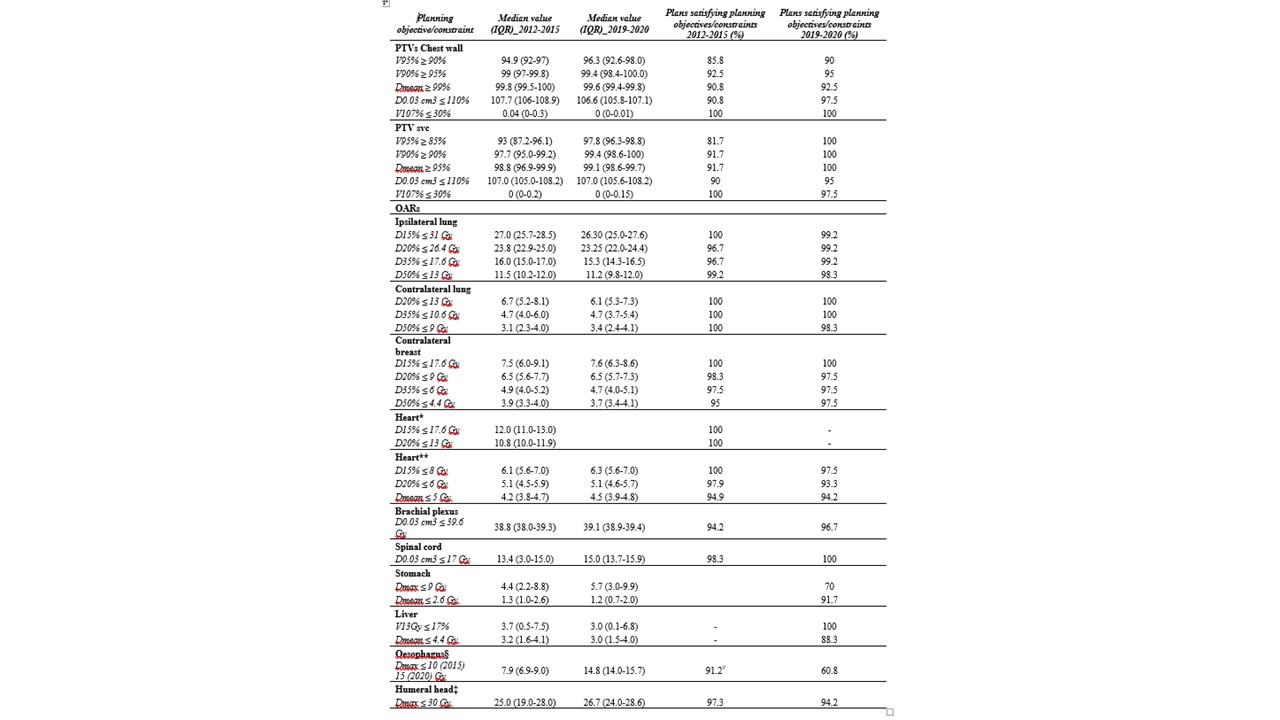Plan quality comparison at 5 years in 2 cohorts of breast cancer patients treated with Tomotherapy®
PO-2044
Abstract
Plan quality comparison at 5 years in 2 cohorts of breast cancer patients treated with Tomotherapy®
Authors: Samantha Dicuonzo1, Mattia Zaffaroni1, Karl Mina Shokry Asaad Amin1,2, Giuseppe Ronci3,4, Micol D’Arcangelo3,4, Maria Giulia Vincini1, Raffella Cambria3, Rosa Luraschi3, Damaris Patricia Rojas1, Maria Alessia Zerella1, Federica Cattani5, Roberto Orecchia6, Maria Cristina Leonardi7, Barbara Alicja Jereczek-Fossa1,8
1European Institute of Oncology IRCCS, Division of Radiotherapy, Milan, Italy; 2University of Milan, Department of Oncology and Hemato-oncology, Milan, Italy; 3European Institute of Oncology IRCCS, Unit of Medical Physics, Milan, Italy; 4University of Milan, __, Milan, Italy; 5European Institute of Oncology IRCCS , Unit of Medical Physics, Milan, Italy; 6European Institute of Oncology IRCCS, Scientific Directorate , Milan, Italy; 7European Institute of Oncology IRCCS, Division of Radiotherapy, Milan, Italy; 8University of Milan, Department of Oncology and Hemato-oncology , Milan, Italy
Show Affiliations
Hide Affiliations
Purpose or Objective
The aim of this analysis was to evaluate the quality of planned dose distribution in two groups of breast cancer patients treated at the same Institution with hypofractionated intensity-modulated radiotherapy (IMRT) delivered using Helical TomoTherapy®.
Material and Methods
Two groups of patients (half treated between 2012 and 2015 and half treated between 2019 and 2020) with implant-based immediate breast reconstruction (IBR) who received post mastectomy RT to the chest wall (CW) and to the infra/supraclavicular nodal region (SVC) using a 15-fraction schedule (2.67 Gy/fraction). The RT treatment was delivered using the TomoTherapy Hi-Art System (Tomotherapy® System, Accuray Incorporated, Sunnyvale, CA) in helical mode. Dose distribution was evaluated according to dosimetric indices extracted from dose-volume histograms (DVHs) selected from those employed in the clinical routine. A quantitative scoring tool, adapted from the one used by Motwani et al., was employed to retrospectively compare the quality of the planned dose distribution between the sub-cohorts of the two treatment groups in terms of both target coverage and sparing of organs at risk (OARs).
Results
A total of 240 patients were included in the analysis. The distribution of total scores resulting from the summation of points and the distribution of planning objectives for planning target volume (PTV) coverage and for OAR sparing are reported in Table 1a. In particular, the percentage of optimal plans increased from 70.8% (2012-2015) to 79.2% (2019-2020), while the percentage of compromised plans decreased from 10.8% to 5.8%. Median values of dosimetric indexes, as well as the percentage of plans satisfying each planning objectives/constraint, both for the individual organs and target volumes, are reported in Table 1b.
Table 1. Recap of the plans’ scores (a) and summary of the planning objective constraints (b)
a)
b)

Conclusion
In conclusion, our experience showed that Tomotherapy in helical modality provides a large proportion of optimal plans in terms of PTV coverage and OARs sparing, in a challenging population of postmastectomy patients with IBR. The learning curve showed that five years apart the rate of optimal plans was increased along with a decrease in the number of compromised plans. This analysis could be a useful platform to compare dose constraints between similar studies and to further refine them to optimize helical PMRT.